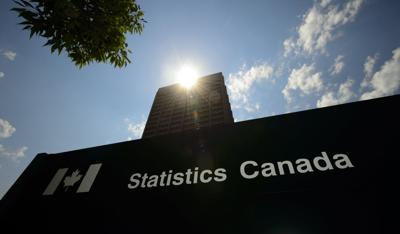Canada’s annual rate of inflation fell in June, Statistics Canada revealed Tuesday, increasing the odds of a Bank of Canada interest rate cut next week.
The Consumer Price Index — a broad-based measure of inflation — was 2.7 per higher in June than a year ago. That’s down from 2.9 per cent in May.Ìý
Lower prices for gasoline were largely responsible for the June decline.Ìý
Tuesday’s news — combined with other recent economic data — should be enough for the Bank of Canada to cut its key overnight lending rate for a second straight meeting next Wednesday, most economists agreed.
“June’s CPI ... was a small relief after an upside surprise in May,” said RBC economist Claire Fan. “We expect the BoC will carry on with easing the monetary brakes on a weak economy, and follow up with another rate cut at its July meeting next week.”Â
“Today’s report has increased odds of back-to-back rate cuts,” wrote TD"s James Orlando. “Recent data have supported a cut, with the job market loosening and wage gains decelerating from elevated levels. From our view, the story hasn’t changed. The BoC is in a cutting cycle.”
There’s plenty of evidence that the Canadian economy is slowing down enough to keep the Bank of Canada on its cutting path, agreed National Bank Financial economists Matthieu Arseneau and Alexandra Ducharme.
Among the factors? A job market they describe as “deteriorating rapidly,” and Tuesday’s inflation report, which also showed consumer spending is slowing down.
“All in all, this morning’s data is consistent with our view that the Canadian economy is in great need of oxygen and we still expect a rate cut in July,” Arseneau and Ducharme wrote in an analysis.
On June 5, the Bank cut the overnight rate by a quarter percentage point to 4.75 per cent, the first time it had dropped below five per cent since last July, and the first time in over four years it had made any cut at all.
In May, Canada’s annual rate of inflation unexpectedly rose to 2.9 per cent, the first increase in four months.Ìý
Inflation peaked at 8.1 per cent in June 2022, as the Canadian economy opened back up from COVID-related restrictions.
The Bank raised rates 10 times between March 2022 and last summer in a bid to wrestle inflation down to its two per cent target.Ìý
The theory is that by making it more expensive to borrow money, consumers and businesses will spend less, driving down prices and slowing the economy.
Tuesday’s inflation report showed evidence that consumers are cutting back on discretionary spending, said BMO’s Benjamin Reitzes.
“The details of the report are consistent with the backdrop of consumers becoming increasingly cautious with discretionary spending,” argued Reitzes, pointing to clothing and recreation, in particular.
In the CPI’s “clothing and footwear” component, prices didn’t just rise more slowly, they actually dropped, and were 3.1 per cent lower in June than they were a year ago.
Shelter inflation, however, continued to be more than double the main headline rate of inflation, with shelter prices rising by 6.2 per cent over the last year.




























To join the conversation set a first and last name in your user profile.
Sign in or register for free to join the Conversation